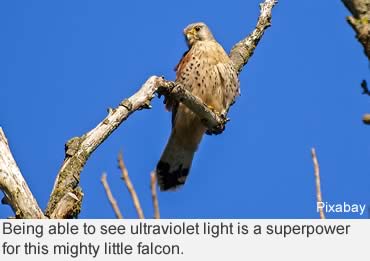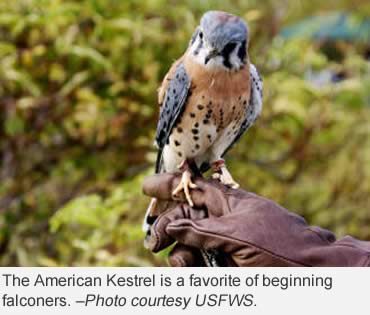Photo: The American Kestrel—a small, fierce raptor.
The American Kestrel is the smallest falcon in North America, but it was once misidentified as a sparrow hawk. Similar in size to a mourning dove, at nine inches in length, with a 22-inch wingspan, and weighing 4.1 ounces, this fierce little raptor has its own superpower—it can see ultraviolet light.
Is that really a superpower? Yes, indeed. It’s a perching bird superpower.
Being able to see electromagnetic radiation, or ultraviolet light, allows the kestrel to follow urine trails on the ground left by voles, one of its common prey animals. It’s a lot like being able to see a road lit by neon lights leading the way in the dark to a diner and the falcon’s next meal.
This small, fierce and intense predator is also one of the most colorful of all raptors. The male has a slate-blue head and wings with a rusty-red back and tail. Females are a bit larger and have the same reddish color on wings, back and tail.
American Kestrels dine on grasshoppers, cicadas, beetles and dragonflies, scorpions and spiders, butterflies and moths, as well as voles, mice, shrews, bats and small songbirds. They also eat small snakes, lizards and frogs, and are feisty enough to take larger prey, such as squirrels and flickers.
Often, they become prey, as well. Despite their ferocious nature, Northern Goshawks, Red-Tailed Hawks, Barn Owls, American Crows, Cooper’s Hawks, and rat and corn snakes hunt them.
 For beginning students of falconry, the American Kestrel is often the first choice for a hunting falcon. Although they are not as strong in flight as larger falcons, many Kestrels successfully hunt sparrows and starlings as well as birds nearly twice their weight.
For beginning students of falconry, the American Kestrel is often the first choice for a hunting falcon. Although they are not as strong in flight as larger falcons, many Kestrels successfully hunt sparrows and starlings as well as birds nearly twice their weight.
Chances are you can find an American Kestrel nearby. Look for them near semi-open grasslands and agricultural fields, in brushy areas near open woodlands and urban areas. They frequently perch on utility lines and poles.
They are cavity nesters, and prefer natural holes and tree crevices. Female and male American Kestrels tend to use different habitats, with females preferring open habitat, while males use areas with more trees.
There are 17 species of kestrels, and these little but mighty falcons can be found from the North American boreal forests of Canada to Tierra del Fuego, the southern-most point of South America. Some, but not all kestrels, are migratory. Kestrels from the northern areas are more migratory than those whose breeding range is farther south, where many populations like to stay put. In America, kestrels are common on both sides of the Continental Divide.
 The smallest falcon is also short-lived. Average life-expectancy in the wild is about 15 months, although the oldest American Kestrel found was a male, aged 14 years and 8 months when he was found in 2001 in Utah, where he was first banded in 1987.
The smallest falcon is also short-lived. Average life-expectancy in the wild is about 15 months, although the oldest American Kestrel found was a male, aged 14 years and 8 months when he was found in 2001 in Utah, where he was first banded in 1987.
Banding studies in Colorado also have shown many kestrels are shot, which is illegal; raptors are federally protected. In some western areas, residents are encouraged to help preserve kestrels by building nesting boxes for their use.
In Nebraska, the Game and Parks Commission has placed an American Kestrel nest box on the north side of its headquarters building in Lincoln. A video feed allows the public to watch as the resident pair lays and hatches their eggs each year.
To learn more about the American Kestrel, click here.
Resources: Nebraska Game and Parks, Utah Department of Natural Resources, Kansas Wildlife, Parks & Tourism, North Dakota Game and Fish Department, Colorado Parks and Wildlife, USFWS.